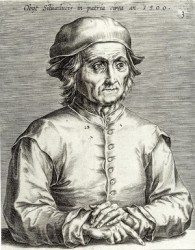
Benesch 1957
“Hieronymus Bosch and the Thinking of the Late Middle Ages” (Otto Benesch) 1957
[in: Konsthistorisk Tidskrift, 26 (1957), Heft 1-2/3-4, pp. 21-42/103-127]
[Reprinted in: Otto Benesch, Collected Writings – Volume II: Netherlandish Art of the 15th and 16th centuries – Flemish and Dutch Art of the 17th century – Italian Art – French Art. Edited by Eva Benesch, Phaidon, New York-London, 1971, pp. 13-35]
[Also mentioned in Gibson 1983: 16 (A74)]
There is not a single formal aspect in the art of Bosch that is not conditioned by the picture content. Moreover this picture content is always conditioned by the special manner in which Bosch saw and experienced the world. No Bosch scholar has succeeded in explaining the ultimate secret of Bosch’s world.
Bosch’s early works show a certain connection with the Flemish School (i.a. Dirc Bouts). Benesch then focuses upon a number of Bosch’s paintings and drawings. Apparently iconography is not his forte (for obvious blunders, see pp. 16, 17, 19, 25, 34). Benesch pays a lot of attention to the style of Bosch, especially to his use of colours.
In his triptychs Bosch presents a ‘Speculum Mundi’, in the manner of the great medieval thinkers of an earlier time. Bosch had an aristocratic and intellectual personality: he was thoroughly versed in literature and knew Latin. He was a ‘naturalist’ and a visionary at the same time because he succeeded in representing the creations of his fantasy in a convincing, realistic way.
Benesch’s approach is very superficial and he commits a number of manifest errors.
[explicit]